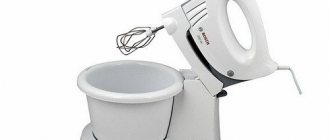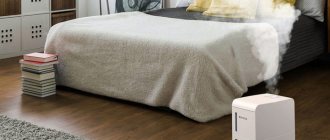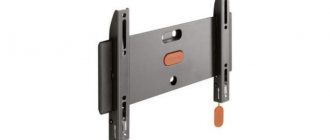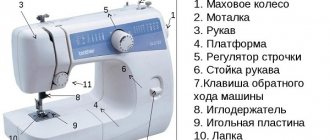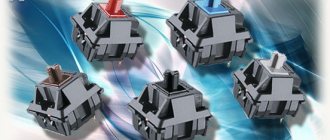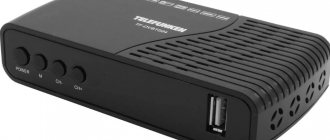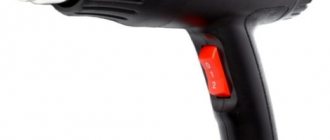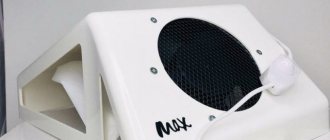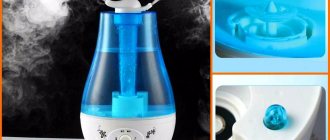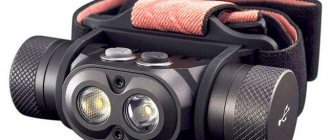Types of laser levels
To choose a laser level, you first need to decide on the type of work for which you will need it. Select a laser level for this type of work. They are of the following types:
- Spot (axis builders). Usually three to five points are displayed in different planes. They do not build any lines or planes. It will be possible to see only dots, but at a great distance (to make it clearer, you can compare their principle with laser pointers). Used on large sites to transfer marks. Useful in repairs for marking lines for wallpapering, marking fasteners for pictures, shelves, etc. In more serious operations this type of instrument is not used.
The simplest laser levels only produce points in one or more planes - Crossliners, line builders, linear levels. Sometimes they are called plane builders, since they essentially form a plane of a certain size (depending on the scan angle). When working with such a laser level, a straight line is displayed on any plane that falls within the laser’s coverage area. This is used in construction and finishing works. The range is usually up to 20 meters, if necessary it can be increased (if there is a mode for working with the receiver). For repairs and interior decoration, it is convenient if the device can form vertical and horizontal lines, and create a “cross” on the floor and ceiling. Due to the peculiarities of beam scanning, the line is displayed only on the part of the room towards which the device is directed. For example, on one wall and part of the ceiling/floor. To get marks on another wall, the device must be turned around.
A linear laser level produces one or more planes with a specific scanning angle - Rotary plane builders. The functions are the same as crossliners, only the planes rotate 360°. A complex system is used for this, which is reflected in the price. Only professionals can justify tools of this type (prices for this type of laser levels start at $400). They are of no use for home use.
Rotating laser levels rotate the plane 360°
Now choosing a laser level is easier, you already know what type of tool you need. For most, this is a line/plane builder.
Personally, I have never seen point laser levels on construction sites or for sale. Therefore, they may not be considered in practical terms as an object for purchase.
Rotary laser levels are usually very expensive and the most accurate (however, more on accuracy below). The price for a decent rotary level starts from 30 thousand rubles and for home use I consider such a purchase not justified.
Therefore, I will focus on plane builders.
There are two types of linear levels
- Level with two beams forward and backward. This is really a laser level and nothing more.
Laser level
2. Plane builder with two or three beams
Laser plane builder
The first type is the simplest and cheapest. But the downside of such a laser level is that it requires skill in obtaining horizontal lines. And the marking speed is not too high. But it can be placed at different angles and it is convenient to mark the same staircase with it. Despite its cheapness, I would not advise you to consider purchasing such a level.
But the second type already has simple automatic self-leveling, it can be easily transported and easily configured for work. It has two beams (vertical and horizontal). Sometimes there is also a third beam, forward-backward or vertical, but it is not really needed. The most advanced ones have up to 5 rays, but this is rarely required in work. The laser builder can also be locked with a special lever and set at any angle.
Advantages and disadvantages of a construction laser level
Measuring devices of this type are distinguished by high accuracy, wide functionality and ease of operation. Almost all models of professional laser levels are programmable. For example, you can set projection in a certain plane, projection clearly by points or at a certain angle. Moreover, in all cases, the device will build perfectly straight lines relative to its position in space.
Laser level Bosh PSL 10 Set - helps to change the angle of view during repair work
There are many benefits to using a laser level.
- Saves time. The device does not need to be specially prepared, launched or configured. Smart technology will do everything itself. It is estimated that the device saves time almost twice when carrying out marking work.
- The measurements are as accurate as possible, because the error of most devices does not exceed 1 mm per meter.
- The device can be installed as close to a corner as possible or even mounted on the wall.
- The device is capable of covering the entire field of work at once. You can immediately mark the places where you will hang a chandelier, nail shelves, or perfectly evenly divide the room with a partition.
- The device is quite easy to use and does not require additional knowledge.
Sometimes it is very necessary to measure the level at a certain height. New generation laser levels will help you do this without much effort.
Among the disadvantages is the need to monitor the batteries (purchase, replacement, charging), as well as the significant high cost of the device.
For your information! Cheaper models use conventional batteries, while more advanced devices use nickel-cadmium batteries.
They can ensure uninterrupted operation of the laser level for 10 hours or more.
Accuracy and range of laser levels
The most interesting thing about laser levels is its accuracy. No matter how perfect the laser is, the further away from the light source, the thicker the beam becomes. Yes, and there is also a deviation from the vertical.
Therefore, in household models, a distance of 10 meters is usually taken, the accuracy is usually ± 0.5 mm/m. That is, at 10 meters the error can be already 5 mm.
There is no need to be afraid of such numbers - a rare room or private house will be 20 meters long, and you can check this length once with a water level. But in a bathroom or an ordinary room, no one will be able to see an error of 1-2 millimeters.
Professional rotary levels provide greater accuracy, but they are also more expensive and require very careful handling.
How to choose
Many people decide to choose a laser level for construction and repair work. The variety of models and different types have made this device quite affordable, and the consumer can only decide which one to choose.
Range
When choosing a device, it is important to determine the measurement range - from 3 to 200 meters. Levels with small parameters are used for markings in small rooms
Such devices are not used on large construction sites, as they need to be rearranged frequently. Devices with high accuracy will not be able to show their full potential in tiny rooms, so you should not overpay for it
Levels with small parameters are used for markings in small rooms. Such devices are not used on large construction sites, as they need to be rearranged frequently. Devices with high accuracy will not be able to show their full potential in tiny rooms, so you should not overpay for it.
Based on this, when choosing a level, adhere to the following rules:
- For work inside small rooms (apartments), a reserve of 10 m is sufficient.
- When working in penthouses, where rooms are more than 10 meters in length, devices with a measurement range of 20-30 m will be used.
- To repair halls, levels of 40-80 meters are used. Larger areas require the use of levels with a beam range of 100 meters or more.
Alignment Features
The following types of instrument alignment are available:
- Manual.
- Auto.
For manual leveling, use a bubble level. It determines the accuracy of the location of the laser device. After alignment, the legs are fixed.
In the automatic type, the emitter is located in a special liquid, which always maintains an even horizontal position relative to ground level. Such models simplify working with them: the device is placed on the surface and the liquid itself corrects the accuracy.
Beam color
When choosing a device, pay attention to the color of the beam. There are devices with green and red light available for sale.
We advise you to study - Classification and types of bits for a screwdriver
The first option is better perceived by the eye, and the second is worse, although the red diodes shine brighter.
When working with a light surface, both types are clearly visible. If you plan to purchase a laser for painting or wallpapering, then experienced builders recommend having both types. This is due to the fact that the green beam is not visible on green wallpaper. The same thing happens with red.
When performing work in open space, it is recommended to use only the green level. It is well perceived by the eye. Red light is almost invisible in bright sunlight.
Number of rays
Different models have the ability to generate different numbers of beams. They work with one beam when it is necessary to create a straight line for shelves or sockets. Two beams are used where right angles need to be created. Four beams cover a large plane, which is convenient for leveling the floor, ceiling, and tension.
Nutrition
There are three types of power:
- Batteries - provides 10 hours of continuous operation. Suitable for home use.
- Battery - used in professional models. Periodically you will have to charge the device.
- Adapter - this type works directly from the network.
Weight
Different models and types have different weights. Not heavy, up to a kilogram can be mounted on the wall. More than 1 kg. are placed on the floor. Professional models can be mounted on a tripod.
Accordingly, the heavier the model, the stronger it is. This is directly related to the material from which the level is made.
For apartment work, a “laser” weighing up to 500 g is suitable. In large rooms, the level will already weigh under a kilogram. Models weighing 4-5 kg are used on construction sites.
Alignment lock
This small but useful feature exists in models with automatic leveling. It allows you to fix the level, preventing the device from turning off or blinking when the degree of inclination changes.
This function is useful for marking at an angle.
Power supplies
Almost all laser levels operate on AA batteries (or rechargeable batteries). They can work on them for 15-25 hours. You can buy them at any hardware store.
The laser consumes a lot of electricity, so you need to buy good lithium batteries.
If you plan to constantly work with a laser level, then you should consider purchasing batteries, otherwise you can go broke on batteries.
Laser levels also usually have a power supply for operation from a wall outlet. But it is inconvenient to use; it is better with batteries.
Protection class of the device housing
If you need to choose a laser level for outdoor work, you need to pay attention to the protection class of the housing. It is designated as IP and two numbers behind it. A level for outdoor use must have IP54 or higher (the numbers may be higher).
This means that the inside of the device is protected from dust, the device is not afraid of rain and high humidity (ADA CUBE PROFESSIONAL EDITION and another model ADA CUBE 3D BASIC EDITION, both for $75).
For indoor work, you can take IP with much lower ratings, but in general, for indoor work, a case with minimal dust protection—IP20 or so—is sufficient.
How to choose a laser level for your home - recommendations from our editors
Before buying a device, the editors of Seti.guru advise you to check its basic capabilities, as well as pay attention to the presence of some important functions.
The main condition for choosing a level is the accuracy of the device’s projection. Checking the basic accuracy parameters is very simple. To do this, you need to attach a sheet of paper or a ready-made target to the wall, at a distance of 2 to 4 meters from the device, on which the beam point will be marked. Then we turn the device to the right until the edge of the beam coincides with the previously marked point. The same action must be done in the other direction. If the level is adjusted correctly horizontally, then the beam of the device should reach the mark in any position. Horizontal deviation of the laser beam indicates its instability.
Scheme for checking a laser level for accuracy.
In addition, it is necessary to check the device for plane tilt. To do this, set a level near the wall, direct the beam to the opposite wall and make a mark, then turn the device around and make a mark behind it. Then repeat the same thing on the opposite wall. If the marks match, then the device is working properly.
Next, it is very important to consider the following device functions and characteristics:
- Working temperature. This indicator is extremely important. Modern devices allow them to be used in different temperature ranges. When choosing a model, it is extremely important to proceed from the tasks that you set for yourself.
- Device body. High-quality protection will protect the device from precipitation and dust. Please note if there are special adjustments on the case that enhance its strength. The strong case can protect the device during a fall from a height of no more than 2 meters.
- Range and visibility of the beam. Find out in advance what the range parameters of the device you have chosen are, as well as how clear and thin the line it will draw. These parameters will be of fundamental importance when working with the device at a long distance or on the street.
- Operating time of the device. The need to purchase an additional battery depends on this.
- Possibility to disable the compensator if available.
Important! The accuracy of the device and other parameters are indicated in the manufacturer's data sheet.
Additional functions
Laser levels also have additional functions:
- Self-shutdown if the device is not moved for more than 10-15 minutes. This mode saves batteries, on the other hand, such shutdowns can be annoying. Whether you need this feature or not is up to you.
- Self-levelling. When deviating from the vertical by a small angle (usually up to 4°), they adjust the position of the mirrors and prisms so that all readings are correct. If the tilt exceeds the maximum permissible, they either make a sound/give a light signal, or turn off the beams. Operation is restored when returning to normal. Almost all modern levels are equipped with this function.
Mounting type
In addition to the standard installation of the laser level on a horizontal plane, there may be several additional options for mounting it:
- On a special tripod. Most often needed for outdoor work, but some work (drawing horizontal lines on walls when hanging furniture, for example) is also easier to do with a tripod. A tripod is sometimes included, sometimes purchased separately. When purchasing, pay attention to the diameter of the thread on the body of the level - the tripod must have the same one.
- On magnets. Some models have magnets soldered into the body. This makes it possible to attach it to any metal surface/part. On a special magnetic stand. Some models of laser levels come with a small plastic pad into which magnets are soldered. A platform is installed on a metal surface, and a level is placed on it.
- Self-tapping screw/nail. A special hole is made in the body of the level into which the head of a nail or self-tapping screw is threaded. Not the most convenient way of fastening, but still.
Everything is clear with these options. You can, of course, do without them, come up with your own way. These are simply opportunities for more comfortable operation.
What else you need to pay attention to is how close you can install the level to the vertical plane. The closer the beam can be located to the wall, the easier it is to level the surface of the wall, mark niches in the wall, etc. This depends on the design of the case - the slots for the rays to exit should either be level with the edge of the case, or even slightly moved beyond it.
Design and principle of operation of a laser level
Laser level device.
Let's look at the design and operating principle of a laser level. The design of the device includes:
- Source of light radiation.
- Optical system.
- Installation mechanism and self-leveling device.
- Power source (mains or battery)
- Controls: remote control and customizable panel.
- Frame.
Sources of light radiation, in these devices these are powerful LEDs, create a beam of a certain wavelength. Modern devices usually use red or green beams. They do not overheat the surface and do not consume a large amount of energy.
For your information! It is believed that red rays with a wavelength of 635 nm are not very well perceived by the human eye. Therefore, more expensive designs use green rays with a wavelength of 532 nm, which is more familiar to humans, which means lines drawn at this level will be more visible. Thus, it will be easier to work with a device with a green beam, even in sunny weather.
The optics built into the device reflects, directs and focuses the radiation in the direction in which it is necessary. The clarity of the beam, as well as the accuracy of the level itself, will depend on its quality.
The optical system is a combination of prisms and lenses. It can be stationary or have a rotating head.
The installation mechanism differs for different types of laser level models. Budget models allow you to set the base of the level manually, while others have a built-in stabilization system. Such mechanisms operate due to a pendulum and a magnetic field, which, when the part is deflected, generates an electric current, with the help of which the device is adjusted. The most advanced models capture the slightest fluctuations - in hundredths and tenths of degrees, which eliminates even the slightest inaccuracies in the process of marking surfaces.
When tilting a level equipped with a self-leveling system, it will begin to emit a specific signal, which will indicate that the device has shifted from the specified coordinates.
All such devices use rechargeable batteries. You can charge them using a special device, it is included in the kit. Under constant load, the device is capable of operating in autonomous mode for about 7-10 hours without interruption.
Manufacturers and models
A good laser level is not only about suitable characteristics and a set of functions. The quality of workmanship is also important, and this depends on the manufacturer. So, along with the characteristics, you will also have to choose a brand. If you have a power tool from a certain company and are satisfied with it, you can also look for a level from the same company. If not, you will have to trust the general opinion.
It is believed that Bosh has good laser levels (line and plane builders). They have household class devices (in a green case), there are professional ones (in a blue case), in each class there are several dozen models with different capabilities and price.
Makita gets consistently good reviews. There are also a considerable number of models, the quality is stable. INSTRUMAX and ADA, which also have many successful models of different types, operate in approximately the same price category. More budget brands include Skill, Robotoolz, Zubr, and RGK.
Selecting a level for outdoor work and complex technical manipulations
The most difficult thing to make the right choice is for those who do not know how to choose a laser level for professional use. In this case, the device will be used constantly, and it will be necessary to solve complex technological problems under difficult operating conditions with its help.
When choosing mechanisms for carrying out work in open areas, you should first of all take into account such a factor as the temperature range at which the unit will be operated. Most often, laser levels and builders are used at temperatures from 5 to 40 ° C, which are also suitable for use in heated rooms. If work is planned to be carried out in the cold season, then the operating range of the device should be from -10 to 40°C. Among the devices that meet these parameters, we should mention KaiTian 5 Lines 6 Points, ADA 2D BasicLevel and KAPRO 888.
We advise you to study - Do-it-yourself technology for laying laminate diagonally
Particularly noteworthy is the ADA 2D BasicLevel builder, equipped with 3 rotating heads, which allows you to create a three-line layout. Additional advantages of the model include good line visibility even at long distances and high construction accuracy. As a result, this unit in any rating is higher than not only budget, but also professional expensive models. Its packaging is also good, including a mount and a magnetic target.
Laser model builder ADA 2D BasicLevel Chinese
Video:
In open areas, it is recommended to use equipment with a high electrical protection class (not lower than IP54), for example, the choice may fall on the KACKAD 2K-IP or ADA 6D Maxliner models. In this case, the equipment will be reliably protected from moisture and dust particles.
Builder KaiTian 5 Lines 6 Points
Laser levels that will be used in open spaces must have a tripod for mounting. If for work in closed buildings you can get by with a device that allows you to mount the unit on the wall or with a small tripod, then for more serious work it is recommended to purchase more serious auxiliary equipment of the same model so that it fits the diameter of the thread.
One of the features of high-tech laser levels is the ability to create laser planes in 2D and 4D formats, as well as project plumb points.
The cost of devices in this category starts from $110. Its good budget representative, included in almost every top laser level, is Condtrol INFINITER CL5, which allows you to quickly and efficiently carry out design work in areas with complex terrain and in buildings with an abundance of structural solutions.
The Bosch PLL 360 laser level is no less effective. The cost of the unit starts from $130, but the level has an excellent set of functions, including the ability to draw not only straight and cross lines, but also circular lines.
So, a high-quality laser level is an indispensable assistant for everyone involved in construction and repair work. A high-quality device allows you to save worker time and perform the most accurate marking, regardless of the complexity and location of the object. Most ratings suggest giving preference to devices in the mid-price category, characterized by excellent functionality and ease of use.
Although the models presented in this review belong to different segments, you can choose the most successful solutions from them based on the ratio of quality and price, as well as the scope of use. The top included an inexpensive laser combined builder made in China, KaiTian 5 Lines 6 Points, costing $50. And in terms of professional level, the ADA TopLiner 3×360 level costs $350. These models were in greater demand. Development in this direction is ongoing and new models are appearing.
Comparative video review of laser levels and builders
Video:
https://youtube.com/watch?v=Zwcj4mYwnPo
Video:
Video:
Parameters for choosing a level for construction/repair
If you are planning a full-scale renovation or starting construction, the following set of characteristics will be optimal for choosing a laser level:
- Two planes - vertical and horizontal with the possibility of their separate inclusion.
- Zenith, nadir and plumb.
- The scanning angle of the planes is about 120-140°; you can get a full 360° by rotating it several times.
- Self-leveling with position change alarm.
- Possibility of locking self-leveling.
- A bright beam with a range of at least 10-15 m.
You may also need a receiver, so the level must work with it.
There is no need to provide specific models and their prices - parameters are constantly improving, and prices are falling. In fact, in construction tool stores you can easily select the necessary model and not put your family on water and pasta.
Chinese laser levels
Advanced Internet users will immediately think of ordering a laser level on the Internet in China on the same aliexpress or gearbest platform. And it is right!
A laser level can be ordered for about 800 rubles, which is very inexpensive.
A higher class laser builder can be purchased for about 2.5 - 8 thousand rubles.
Personally, I did just that 2 years ago and bought myself a Kai Tian laser builder. Then it cost about 2200 rubles. Now I don’t see such a model, but prices have become about 3.6 thousand or more rubles.
The equipment is quite rich:
- Hard carrying box;
- The level itself has legs;
- Cord and power supply for mains operation;
- Red glasses (for work - in the sun they improve the visibility of the beam).
Unfortunately, I was greedy then and did not buy a tripod and an adapter for the level. I have tripods for my camera, I was hoping it would fit, but it didn't fit the screw. And the tripod for the level has a smooth lifting handle, which is very convenient for adjusting the installation height of the level (I worked with a similar level at work).
The level arrived in about 1.5 months, everything was in order - the seller packed it well.
In principle, I am satisfied, as are all those to whom I let work with him.
Flaws
Just like all technology has its pros and cons, there are also disadvantages here. This is not to say that there are many of them, but a couple can be singled out.
1. This is, of course, the price. All laser levels with an optical design of 3-360° or 4-360°, that is, three or four planes, respectively, 360 degrees each, are quite expensive. Although today you can buy such a device for quite reasonable money, the only thing is that you will have to wait a little until it is delivered. When purchasing a laser level from Aliexpress, the waiting period can be from 3 to 20 days, depending on your place of residence and the place of shipment.
It is harmless and extremely profitable, at least 2-3 times cheaper. Here are reviews of several proven models that you can order: Fukuda MW-93T-3GX, a very high-quality level Huepar 603CR, Firecore F93T-XG, or for example the cheapest model, with its drawbacks of course - the green laser level HILDA 3D LS055. In fact, there are quite a lot of them, look on the website.
2. The second and final disadvantage is the often thicker and more heterogeneous line compared to devices with cylindrical prisms.
But this feature is not found in all samples, but only in some, and what exactly this is connected with is not clear, one can only speculate. Moreover, it happens to all manufacturers, regardless of regalia.
Nevertheless, manufacturers are aware of this problem and are looking for solutions to fix it.
